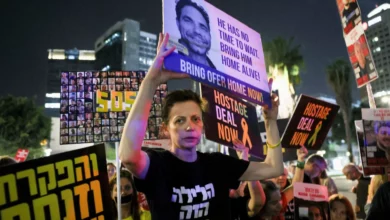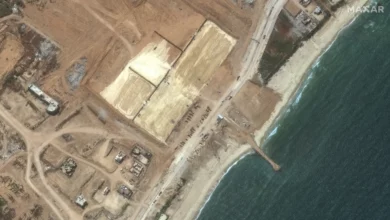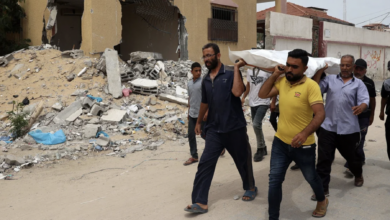
Editor’s Note: A version of this story appears in CNN’s Meanwhile in the Middle East newsletter, a three-times-a-week look inside the region’s biggest stories. Sign up here.
Israeli Prime Minister Benjamin Netanyahu told CNN in an interview on Sunday that his country’s policy is to let as much humanitarian aid into Gaza as is necessary, a claim that has been disputed by aid agencies and even contradicts his own statements.
In an interview with CNN’s Dana Bash, Netanyahu sought to shift the blame for aid not getting into Gaza from his government and onto Hamas, accusing the group of looting relief supplies.
The prime minister’s remarks come amid rising criticism of Israel’s military campaign in the Gaza Strip, launched in the wake of Hamas’s October 7 attacks that left around 1,200 people killed and another 250 taken hostage. Israel says its operation is meant to only target Hamas fighters and not Palestinian civilians.
Israel’s campaign has killed more than 31,000 people in Gaza, more than 70 percent of whom are women and children, according to the territory’s health ministry, causing widescale destruction, mass displacement and a looming famine.
The United Nations, European Union and Israel’s closest ally, the United States, have all criticized its policies, calling on Netanyahu to allow more aid into the besieged enclave.
In his interview with CNN, Netanyahu made several claims about his country’s aid policy in Gaza. CNN breaks down those claims and what aid groups have said about them.
Netanyahu says Israel’s policy is to allow as much aid ‘as needed’
“Our policy is to not have famine, but to be the entry of humanitarian support as needed, and as much as is needed,” Netanyahu told CNN.
The Israeli leader’s claim contradicts statements he made previously, in which he boasted about permitting “minimal humanitarian aid” to enter Gaza.
“We provide minimal humanitarian aid,” Netanyahu said at a press conference in January. “If we want to achieve our war goals, we give the minimal aid.”
Netanyahu’s war policies have also hindered aid.
Less than two days after Israel began its military operation in Gaza, it placed the strip under what Defense Minister Yoav Gallant called a “complete siege,” halting supplies of electricity, food, water and fuel to the enclave. When aid finally began entering Gaza, it was only a trickle through a process that aid workers and the UN say is long, complicated and arduous.
Aid workers and government officials say a pattern has emerged of Israeli obstruction, where Israel’s Coordinator of Government Activities in the Territories (COGAT), the agency that controls access to Gaza, has imposed arbitrary and contradictory criteria on relief entering the territory. “It’s deliberately opaque, deliberately ambiguous,” one relief worker said of the aid delivery process.
“I’ve never seen a supply chain that ought to be so simple be so complicated,” Save the Children US president and chief executive Janti Soeripto told CNN last month. “The level of barriers being put in place to hamper humanitarian assistance – we’ve never seen anything like it.”
Trucks carrying aid must pass through three layers of inspection before they can enter the enclave, Martin Griffiths, the UN under-secretary-general, has said. Long linesfor inspection have led to bottlenecks at the Rafah crossing, the UN’s World Food Programme (WFP) said, with the list of rejected items – or “dual-use” equipment – only growing.
Despite calls on Israel to open more crossings into Gaza, aid is restricted to only two land crossings – the Rafah crossing with Egypt, and the Kerem Shalom crossing with Israel.
Israel however has a total of six crossings into Gaza, some of which haven’t been operational for over a decade. Egyptian foreign minister Sameh Shoukry last week called for Israel to open them.
For months, lines of trucks bound for Gaza have been backed up along the highway leading from the Egyptian town of Arish, a major logistical hub for aid, to the Rafah crossing. In a satellite image from late last month a line of trucks could be seen stretching out for 4 miles from the crossing.
Even when relief does enter, Israeli bombardment, damage to roads from airstrikes, communications blackouts and mass displacement impede distribution within the enclave.
Last month, Israeli forces fired on a UN convoy carrying food supplies in central Gaza before ultimately blocking the trucks from progressing to the northern part of the territory, according to documents shared by the UN and CNN’s own analysis.
Israel has also been working to dismantle the main aid agency that has handled aid distribution in Gaza for decade, the UN’s agency for Palestine refugees (UNRWA), accusing some of its staff of being involved in Hamas’ October 7 attack.
Netanyahu lauds ‘alternative supply routes’
Netanyahu said that Israel has created “alternative routes” to deliver aid, including through airdrops, shipments by sea, and “land routes.”
Only two land crossings have been used to deliver aid to Gaza – the Rafah crossing with Egypt, and the Kerem Shalom crossing with Israel. But volumes are insufficient compared to the scale of suffering.
Israel has however tested a pilot program to deliver desperately needed aid to northern Gaza through another border gate, but only six trucks had crossed it as of last Wednesday.
And while Israel has indeed allowed airdropped and maritime relief, aid groups say it’s nowhere close to enough to alleviate a looming famine, and warn that it could undermine land-based deliveries.
Only one ship has so far delivered aid to Gaza, carrying the equivalent of one meal each for a quarter of the enclave’s more than 2 million people. With 200 tons of aid on board, the ship delivered the equivalent of about 10 trucks’ worth of relief.
More shipments are expected, but the process is slow and complicated, especially as there are no functioning ports left in Gaza to efficiently receive the aid.
In a joint statement released by Amnesty International, 25 non-governmental organizations last week called on governments to prioritize land-based aid deliveries, saying “states cannot hide behind airdrops and efforts to open a maritime corridor to create the illusion that they are doing enough to support the needs in Gaza.”
The NGOs also warned against “the potential devastating consequences of creating dangerous precedents” that risk the degradation of land-based humanitarian access, as well as prolonging hostilities.
Netanyahu says Israel is allowing more trucks in
“The problem is not the number of trucks going in, although we’re increasing it on a daily basis,” Netanyahu said.
Aid groups and the UN have said that the main problem hampering humanitarian aid in Gaza is the small number of trucks entering the enclave due to Israeli restrictions.
An average of 95 aid trucks per day entered Gaza between October 10 and February 1, according to the Palestinian Red Crescent, down from 500 trucks a day before the war through the Rafah crossing alone.
Netanyahu says Israel is increasing the number of trucks each day. While March saw an uptick in the number of trucks crossing, the UN has suggested that the volume of aid has been fluctuating.
The first 15 days of March saw an average of 165 aid trucks per day cross into Gaza, UNRWA reported Sunday. The figure is higher than the average 95 trucks per day, but it remains well below the 500 needed per day.
UNRWA Commissioner-General Philippe Lazzarini last month said that the volume of aid into Gaza halved between January and February.
Netanyahu claims Hamas is looting trucks
Netanyahu told CNN Sunday that Hamas is the main obstacle to aid deliveries and is looting incoming aid. Israel hasn’t provided any evidence to back that claim.
The UN and other aid groups have reported some of their aid trucks had been looted, but haven’t ascribed any blame for it. Looting has been attributed to extreme levels of hunger and the breakdown of social order.
When the World Food Programme (WFP) halted aid delivery in northern Gaza, it cited safety concerns, saying there is “complete chaos and violence due to the collapse of civil order.”
And when it tried to deliver a 14-truck food convoy this month, it was turned back by the Israeli Defense Force (IDF) after a three-hour wait at the Wadi Gaza checkpoint, WFP said.
“After being turned away the trucks were rerouted and later stopped by a large crowd of desperate people who looted the food, taking around 200 tons from the trucks,” the agency said.
Previous reporting by CNN’s Tamara Qiblawi, Allegra Goodwin, Nima Elbagir, Caroline Faraj, Kareem Khadder, Barbara Arvanitidis, Mark Baron, Alessia Tinti, Mary Rogers, Alex Platt, Abeer Salman, Katie Polglase, Muhammad Darwish, Celine Alkhaldi and Niamh Kennedy




